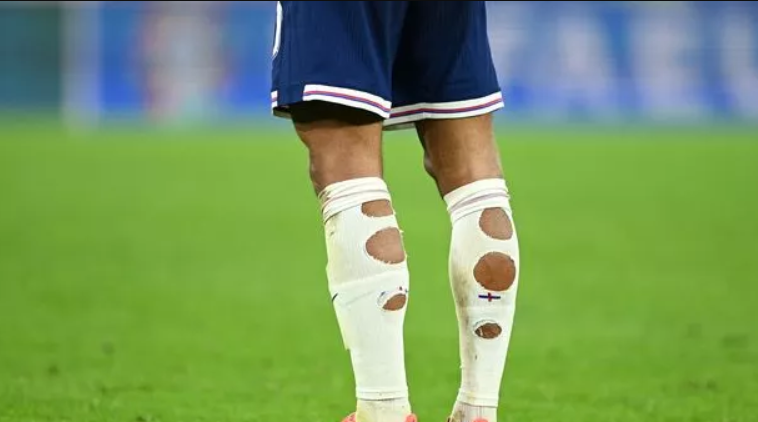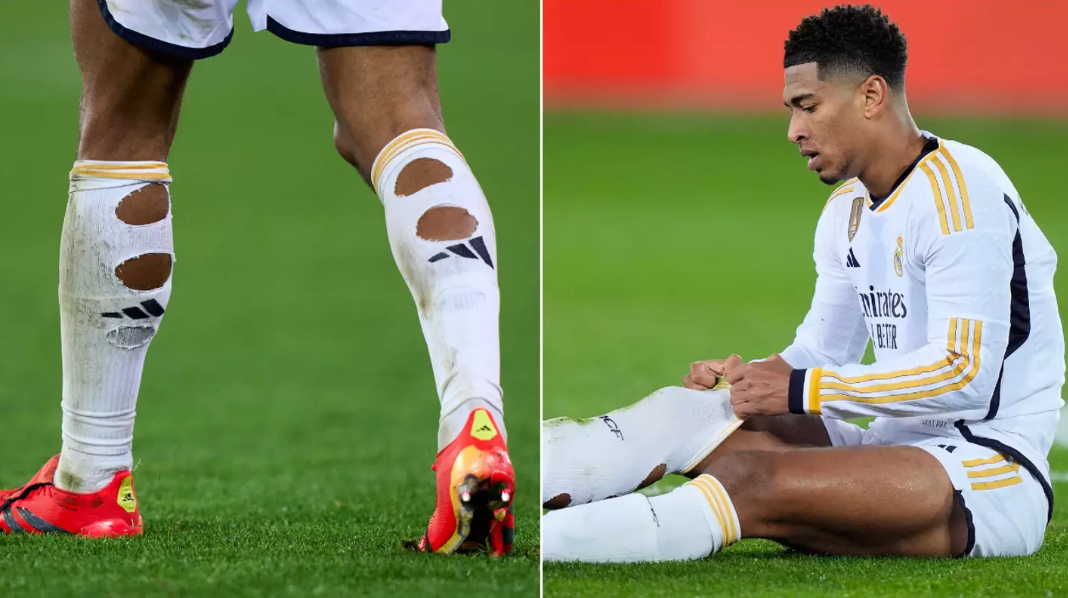Footballers like Jude Bellingham often cut holes in their socks due to a simple and practical reason: comfort and performance enhancement. Footballers’ footwear is extremely significant in the game as it directly impacts their performance. Socks, a crucial part of their gear, are designed to provide support, enhance grip, and protect from blisters.
However, these socks are usually tight around the calf area, which can limit the athletes’ comfort and impede their flexibility, potentially affecting their performance on the pitch. By cutting holes in their socks, footballers like Bellingham aim to alleviate this tension and increase ease of movement.
This little adjustment enables them to feel more comfortable and flex their calf muscles without any restriction, potentially giving them an edge in the game. It’s a common practice among many footballers, not just Bellingham, and reveals the lengths athletes will go to for even the slightest advantage or increase in comfort during a game. It is fascinating to observe how even seemingly minor alterations can have a significant impact on the performance of professional footballers.

Exploring the Practical Reasons for Sock Alterations by Footballers
Sock alterations by footballers have emerged as a common practice in the modern football world for various practical reasons. The primary reason is to improve comfort and performance on the pitch. Footballers often find the standard issue socks too thick and restrictive, which can hamper their agility and speed. By modifying, typically cutting the feet off their team socks and wearing a thinner, more comfortable sock underneath, they can enhance their feel of the boot and subsequently their ball control.
Another significant reason is to prevent or manage existing injuries. Footballers often suffer from blisters, calluses, and other foot issues due to the intense physical demands of the sport. Using their preferred socks can aid in alleviating these problems, providing a better fit and minimizing friction.
Additionally, some footballers use sock alterations as a means of self-expression. This allows them to stand out on the field and demonstrate their unique style. For instance, certain players pull their socks over their knees to emulate their footballing heroes or as a superstition.
Lastly, footballers may alter their socks to accommodate specific sports equipment. Shin guards, which are a mandatory piece of equipment in football, often require players to adjust their socks for a proper fit. This is important to ensure their safety during the game.
In conclusion, while sock alterations by footballers may seem trivial to some, they serve multiple practical purposes. From improving comfort and performance, preventing injuries, expressing personal style, to fitting equipment properly, these modifications reflect the individual needs and preferences of the players in the pursuit of excellence in their sport.
How Cutting Holes in Socks Can Improve Player Performance
Cutting holes in socks can potentially enhance player performance in a variety of sports, particularly in activities that require prolonged periods of running or walking. This unconventional technique principally aids in alleviating pressure points and reducing friction, thereby minimizing the risk of blisters and sores that can hamper an athlete’s performance. The holes in the socks allow better air circulation, which can keep the feet cool and dry, reducing sweat accumulation that often leads to discomfort and irritation during extended periods of play.
Additionally, the holes can have a slight compression effect in certain areas, providing increased support and stability for the foot. This can help to improve balance and coordination, which are crucial elements for peak performance in many sports. The holes can also serve to lessen the overall weight of the socks, which, while seemingly insignificant, can make a difference in sports where every ounce counts.
Moreover, this method can be customized to suit individual needs. For instance, athletes can cut holes in specific areas where they are prone to blisters or discomfort, thus creating a personalized sock that caters to their unique foot structure and movement patterns.
Therefore, through a combination of enhanced comfort, improved circulation, reduced weight, and personalized fit, cutting holes in socks can serve as an innovative strategy to boost player performance in sports. It’s a simple, cost-effective solution that can be easily implemented by any athlete looking to gain an edge in their performance. However, it’s important to note that this technique may not be suitable for everyone and should be used with care to avoid causing any potential harm to the foot.

The Importance of Comfort and Fit in Football Gear
In the exhilarating world of football, the significance of comfort and fit in football gear cannot be overstressed. Achieving optimal performance on the field is not only tied to the skills, drills, and strategies of the game, but also significantly influenced by the type and quality of equipment players wear. A perfect-fit helmet, snug cleats or well-padded shoulder pads can make a world of difference between an extraordinary play and a potential injury. Wearing ill-fitted gear can distract a player, hinder movement, and even lead to unnecessary and preventable mishaps.
Comfort in football gear contributes to the player’s confidence and focus on the field. With gear that fits properly, a player can concentrate on the game rather than dealing with discomfort, irritation or the constant need to readjust their equipment. Furthermore, comfort and fit also enhance the player’s agility, speed, and overall performance.
Fit is also paramount for protection. Helmets and pads should be secure enough to stay in place during rigorous movement, but not so tight as to restrict circulation or cause discomfort. A well-fitted helmet can protect the player from concussion, while properly sized pads can shield the body from high-impact collisions.
An often overlooked aspect is the psychological boost that comfortable and fitting gear provides. When players are confident in their equipment, they tend to play more aggressively and assertively, which can be an edge in competitive sports like football.
In conclusion, the importance of comfort and fit in football gear transcends mere aesthetics or tradition. It is an integral part of player safety, performance, and confidence. Therefore, investing in high-quality, well-fitted gear should be a top priority for anyone involved in this dynamic sport.
Notable Examples of Footballers Who Modify Their Socks
In the world of football, it is not uncommon for players to modify their socks in order to enhance comfort, performance, or simply to make a fashion statement. There have been many notable examples of this practice among top-level footballers. One such player is Neymar Jr., the Brazilian superstar, who is frequently seen on the pitch with his socks rolled down.
This modification is thought to facilitate better blood circulation in his calves, allowing him to perform at his best for longer periods. Lionel Messi, the Argentine maestro, is another player who is known for his unique sock customisation. He typically wears his socks low to expose his ankles, which is said to increase his agility and quickness on the field. Then there’s Raheem Sterling, the England international, who cuts off the bottoms of his socks and pulls them over his calves for a snug fit.
This modification provides him with the necessary grip without restricting his movement. Lastly, Gareth Bale, the Welsh wizard, cuts holes in his socks to prevent pressure build-up, thereby reducing the risk of muscle injuries. These alterations, while seemingly minor, can make a significant difference in a footballer’s performance, and it is interesting to see how each player adopts their own unique modifications to suit their style of play and physical needs.

The Effect of Sock Modifications on Modern Football Strategies
The evolution of modern football strategies has been significantly influenced by various factors, one of which is sock modifications. The introduction of performance-enhancing socks has had a profound effect on the way footballers play the game. These specifically designed socks, often crafted with advanced technology, can potentially increase a player’s agility, speed, and overall performance. They are designed to provide additional support to the foot, reduce muscle fatigue, and enhance blood circulation, thereby enabling players to maintain their physical performance throughout the match.
Moreover, these modified socks can also help in reducing the risk of injuries. They are designed with special padding and protective areas that safeguard vulnerable parts of the foot. This protection can improve player safety, allowing them to execute more daring moves and strategies without the fear of injury.
Additionally, the psychological aspect cannot be overlooked. Players who believe that their gear is top-notch may perform better due to increased confidence. Hence, sock modifications can indirectly affect the mental game, which is a crucial part of football strategies.
These sock modifications have also led to changes in team strategies. Coaches and managers have had to adapt their game plans to accommodate the changing physical potential of their players. For example, strategies might be adjusted to utilize a player’s enhanced speed or stamina, made possible by these advanced socks. Therefore, these seemingly minor changes in football gear have had a profound impact on the game, reshaping strategies and altering the physical and mental dynamics of modern football.
In conclusion, the effect of sock modifications on modern football strategies is multifaceted. They have not only improved player performance and safety but have also sparked changes in the tactical approach to the game. As technology continues to advance, it will be interesting to observe how more such innovations can further shape the beautiful game’s strategies.
